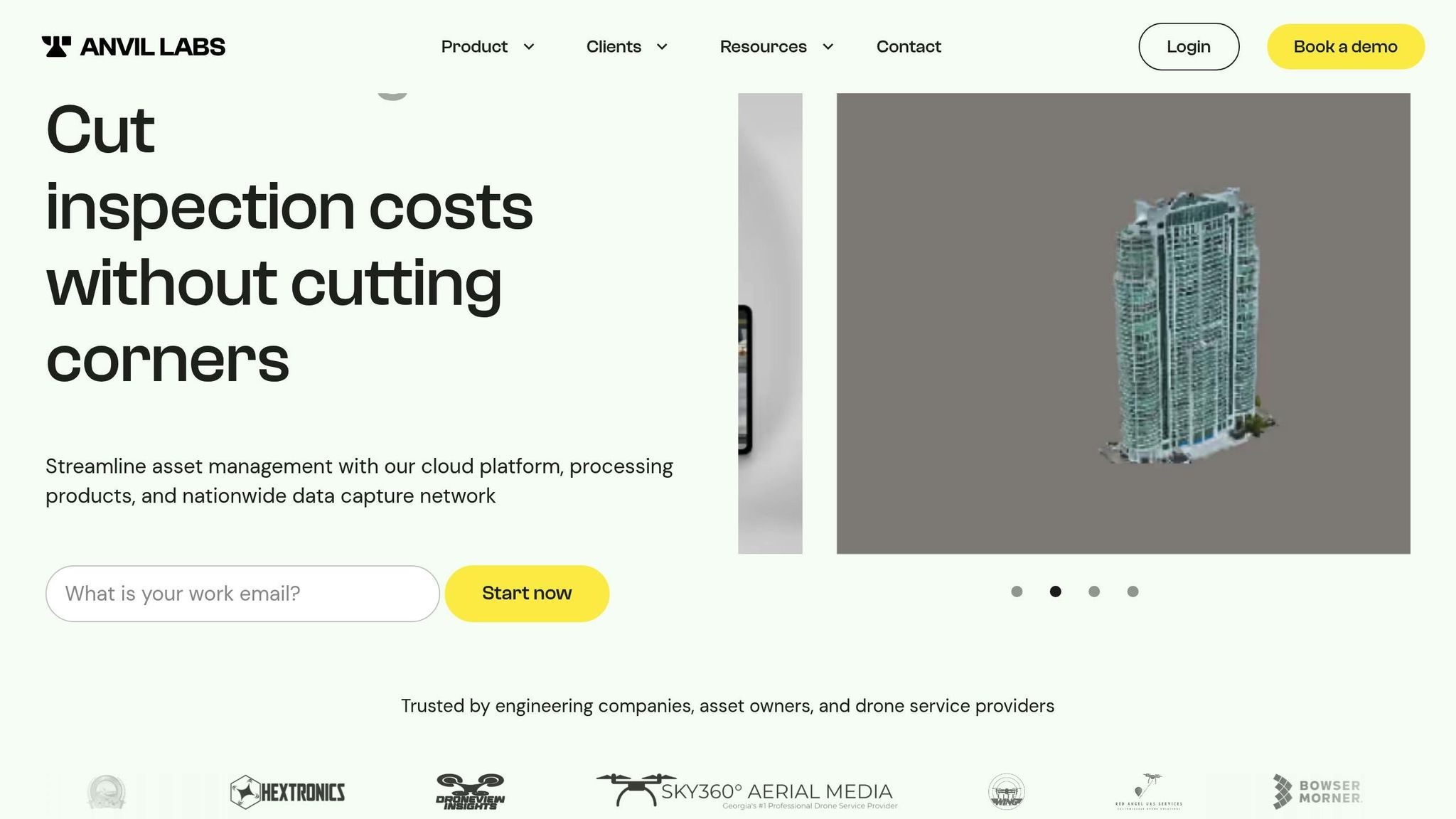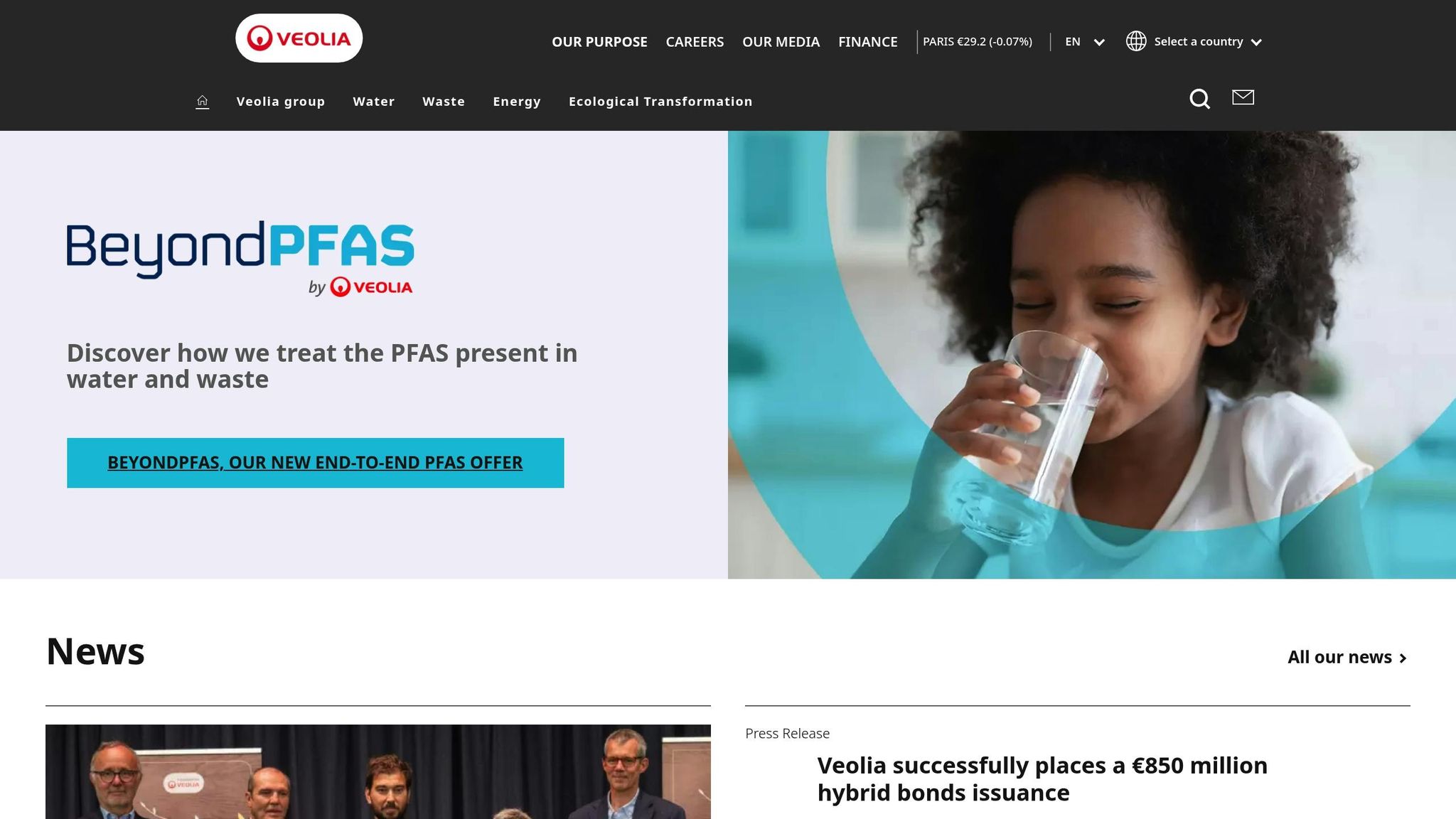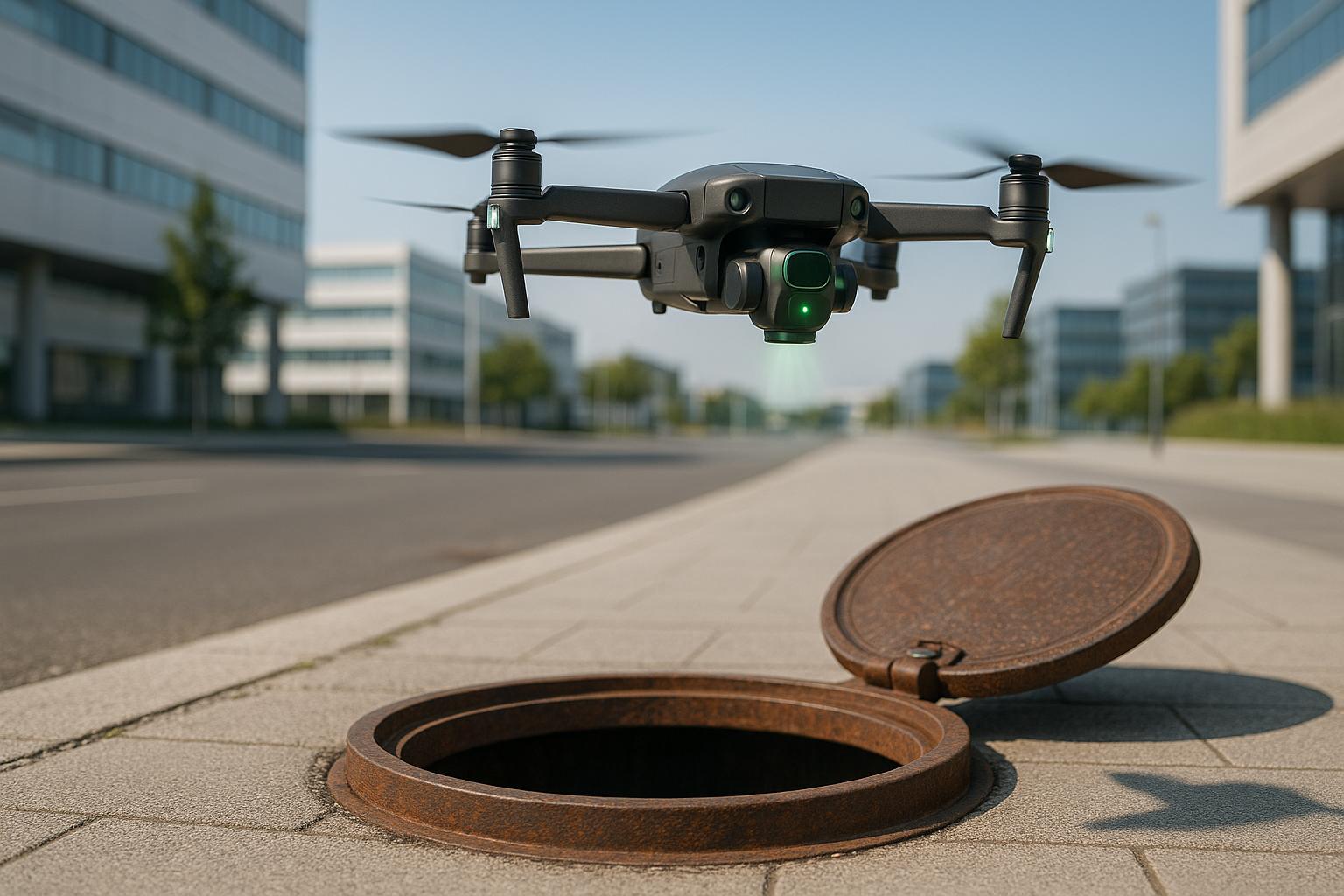Drone technology is changing how sewer systems are inspected and maintained. Instead of relying on outdated methods like manual inspections, drones equipped with advanced sensors now collect detailed data on sewer conditions. This includes high-resolution images, thermal readings, and gas measurements, which are processed into models that help predict corrosion more accurately. By using this approach, municipalities can identify issues early, improve safety, and reduce costs associated with emergency repairs.
Key Takeaways:
- Why It Matters: Sewer corrosion, caused by hydrogen sulfide gas, leads to costly damage and health risks.
- Traditional Limitations: Manual inspections are inconsistent, unsafe, and only cover small areas.
- What Drones Do: Collect precise data using cameras, thermal imaging, LiDAR, and gas sensors.
- Benefits: Broader coverage, better predictions, safer operations, and lower maintenance costs.
- Future Trends: AI, digital twins, and automated flight planning are advancing sewer monitoring.
This shift to data-driven maintenance is helping municipalities extend the life of aging infrastructure while addressing problems before they escalate.
How Drone Data Improves Corrosion Prediction Accuracy
Types of Data Drones Collect
Drones equipped with specialized sensors provide a wealth of information that paints a detailed picture of sewer system health. High-resolution cameras capture images that highlight cracks, discoloration, and early signs of corrosion. Thermal imaging sensors detect temperature variations along pipe walls, pinpointing areas where active corrosion might be occurring. LiDAR sensors create 3D models of pipe geometry, enabling precise monitoring of structural changes over time. Additionally, gas sensors measure chemical markers like hydrogen sulfide and pH levels, offering early warnings of potential corrosion risks. Together, these diverse data sources form the backbone of predictive models, giving engineers the tools to anticipate future deterioration with greater precision.
Integrating Drone Data into Predictive Models
Advanced platforms transform raw drone data into actionable insights. For instance, Anvil Labs processes drone-collected imagery, thermal readings, LiDAR data, and gas measurements into interactive systems. These platforms leverage machine learning to analyze the data, identifying subtle signs of emerging damage. Predictive models can also incorporate external factors like historical maintenance records, weather conditions, and usage patterns, further sharpening their accuracy. With real-time updates, these systems allow for more frequent monitoring compared to traditional periodic inspections. This seamless integration of data and analysis drives smarter, more efficient maintenance strategies.
Research-Backed Benefits
Studies have shown that drone data significantly enhances the accuracy of corrosion predictions compared to traditional methods. This improvement directly supports better maintenance planning, enabling teams to address potential issues early - long before they escalate into costly failures. Unlike conventional inspections, which often cover only a fraction of sewer networks due to access and safety limitations, drones provide broader coverage, reducing the risk of missed problem areas. This comprehensive monitoring approach not only optimizes repair scheduling but also helps cut costs by minimizing emergency interventions and extending the lifespan of critical infrastructure.
Technologies and Workflows for Drone-Based Sewer Inspections
Key Sensor and Data Processing Technologies
Modern drone inspections rely on a range of advanced tools, including thermal cameras, orthomosaic imaging, LiDAR, and gas sensors. Each serves a specific purpose:
- Thermal cameras detect temperature changes, helping to identify leaks or structural weaknesses.
- Orthomosaic imaging produces detailed, high-resolution maps of sewer systems.
- LiDAR creates precise 3D models of pipe geometry, offering a clear view of structural conditions.
- Gas sensors measure hydrogen sulfide and pH levels, which are critical for identifying corrosive environments.
By combining these technologies, drone inspections deliver a level of detail and accuracy that traditional methods simply can’t achieve. This integration allows for better corrosion predictions and supports in-depth structural analyses, paving the way for smarter maintenance planning.
Standard Drone Inspection Workflow
Drone-based sewer inspections follow a structured process to ensure thorough and reliable results:
- Pre-Flight Planning: Teams begin by mapping out access points, identifying potential safety risks, and designing flight paths that guarantee complete coverage of the inspection area.
- Data Collection During Flight: Drones fly along pre-planned, overlapping routes to gather thermal images, photographs, LiDAR scans, and gas readings. Operators monitor the data in real time to ensure quality and coverage.
- Post-Flight Data Processing: Once the flight is complete, raw data from the sensors is processed into usable formats - like calibrated thermal images, detailed 3D models, and organized maps - ready for analysis.
- Final Analysis and Reporting: All data sources are integrated to create comprehensive inspection reports. Teams assess thermal anomalies, examine structural shifts, and correlate gas readings with visual signs of corrosion, helping prioritize maintenance actions.
Role of Platforms like Anvil Labs

Platforms like Anvil Labs play a vital role in turning raw drone data into actionable insights. By hosting a variety of data types - 3D models, thermal imagery, LiDAR scans, and orthomosaics - in a single, unified system, these platforms simplify data management and analysis.
Key features include:
- Annotation and Measurement Tools: Engineers and inspectors can mark problem areas directly on 3D models or thermal images, document corrosion severity, and measure crack lengths. This creates a detailed, permanent record for long-term asset management.
- Secure Collaboration: With features like role-based access controls and audit trails, sensitive infrastructure data can be securely shared among field teams, engineers, and municipal leaders, ensuring everyone has access to the information they need.
- System Integration: Anvil Labs connects drone inspection data with existing maintenance management systems and AI tools. This allows for automatic updates to asset databases, the generation of maintenance work orders, and the use of predictive models based on the latest data.
Impact on Maintenance Planning and Efficiency
Preventive Maintenance and Asset Longevity
Drone-based corrosion predictions are reshaping how sewer system operators handle maintenance. Instead of waiting for pipes to fail or relying on routine inspections that might miss early signs of wear, operators can now spot issues early and address them before they escalate. This shift toward preventive maintenance means repairs can be scheduled during planned windows, reducing costly emergency fixes and extending the lifespan of assets. Early detection allows for targeted solutions - like applying protective coatings, installing liners, or making spot repairs - which help safeguard existing infrastructure and keep sewer systems operational longer. The precision of drone data not only avoids emergencies but also supports a more data-driven approach to maintenance. This proactive method stands in stark contrast to older, less efficient practices.
Comparing Standard vs. Drone-Based Approaches
Traditional inspection methods often require workers to enter confined spaces and perform extensive on-ground tasks, increasing safety risks and slowing the process. Drone-based inspections, on the other hand, are faster and more thorough. With highly accurate data, maintenance efforts can focus on clearly identified problems, reducing unnecessary work and ensuring no issues are overlooked.
Benefits for Municipal and Private Operators
Beyond improved accuracy and safety, drones bring operational and regulatory advantages. Municipalities and private operators can rely on precise drone data to allocate resources more effectively, addressing the most urgent repair needs.
Another advantage is the minimal disruption caused by drone inspections. With less setup and no need to halt regular operations, these inspections allow day-to-day activities to continue smoothly while also reducing risks to workers by limiting their exposure to hazardous environments.
Moreover, the detailed reports generated from drone data make it easier to comply with regulatory requirements. These comprehensive records support audits and assessments while also improving communication with stakeholders. Operators can clearly explain the issues identified and the reasoning behind their repair strategies. The efficiency and precision of drone technology are redefining how sewer systems are maintained, offering a smarter, safer, and more reliable approach.
sbb-itb-ac6e058
Future of Drone-Enabled Sewer Corrosion Monitoring
New Technologies and Developments
The world of sewer corrosion monitoring is undergoing a transformation, thanks to cutting-edge advancements in drone technology. These innovations are pushing the boundaries of what’s possible in infrastructure maintenance.
Today’s drones are equipped with AI-powered systems that analyze visual data in real time. This means they can instantly detect corrosion patterns and structural weaknesses, cutting out the need for lengthy manual reviews. The result? Faster and more accurate feedback.
On top of that, thermal sensors are now capable of spotting temperature changes that signal reactive processes, while enhanced LiDAR technology creates incredibly detailed 3D maps of pipe interiors. Together, these tools offer a full picture of sewer health, making it easier to pinpoint problem areas.
One of the most exciting developments is the integration of digital twin technology. By combining drone data with historical records, flow patterns, and environmental factors, digital twins can predict how corrosion will progress and suggest targeted maintenance strategies. This dynamic system continually updates itself, making it smarter with every inspection.
Machine learning is also stepping up. With access to vast amounts of inspection image data, these algorithms can now detect even the faintest signs of deterioration. They’re so precise that they can distinguish between different types of damage, helping teams decide on the best repair methods.
Finally, drones are becoming even more efficient with automated flight path mapping. These systems plan routes through complex sewer networks, taking into account varying pipe sizes and access points. This ensures thorough coverage without wasting time or resources.
Challenges and Opportunities
While these advancements are promising, they also come with their own set of hurdles and opportunities.
One major issue is the regulatory landscape. U.S. regulations haven’t kept pace with the rapid evolution of drone technology. Many municipalities are still unclear on standards for drone-based sewer inspections, including how often inspections should occur and what level of accuracy is acceptable. Federal agencies like the EPA are working on updates, but progress is slow compared to the speed of innovation.
Another challenge lies in managing the sheer volume of data generated by these inspections. Without proper systems in place, the influx of information can overwhelm existing infrastructure. However, when handled effectively, this data can provide deeper insights into sewer health and long-term maintenance needs.
The skills gap is another pressing issue. Operating advanced drones and interpreting complex sensor data requires specialized training, which many municipal workers currently lack. This opens the door for new professional development programs and partnerships with tech providers to bridge the gap.
Cost is also a concern, especially for smaller municipalities. While drones can save money in the long run by reducing maintenance costs, the upfront investment in equipment, software, and training can be steep. Fortunately, federal infrastructure funding programs are starting to address this issue, offering grants and cost-sharing options to ease the financial burden.
As these systems become more connected, cybersecurity risks are growing. Protecting sensitive data while enabling collaboration between departments and contractors requires robust security measures, which many organizations are still working to implement.
On the flip side, there’s a huge opportunity for standardization. As more operators adopt drone-based inspections, creating industry-wide standards for data collection and reporting could streamline workflows and improve consistency. This would also make it easier to compare performance across different sewer networks and share best practices.
Public-private partnerships are emerging as a key driver of progress. By collaborating with technology companies, municipalities can run pilot programs that demonstrate the benefits of drone inspections while sharing costs and risks. These partnerships often pave the way for broader adoption as others see the results.
Platforms like Anvil Labs are tackling many of these challenges head-on. Their systems are designed specifically for infrastructure inspections, handling everything from 3D models and thermal imagery to LiDAR data. They also offer secure data-sharing features, helping operators meet regulatory requirements and work more effectively with contractors and stakeholders. This shift toward integrated, data-driven solutions is setting a new standard for sewer maintenance.
Sewer Inspection Drone. Veolia increases sewer inspection efficiency with Elios 3 drones.

Conclusion: The Role of Drone Data in Revolutionizing Sewer Maintenance
Drone technology is reshaping how sewer corrosion is predicted and managed. Instead of relying on reactive methods and educated guesses, municipalities and private operators are now turning to precise, data-driven strategies that protect infrastructure while cutting costs.
Drones equipped with advanced sensors are uncovering corrosion patterns that traditional methods often miss. By offering precise detection and modeling, they enable early intervention and targeted maintenance. This shift from reactive to proactive maintenance is already delivering measurable benefits for sewer systems, both public and private. These advancements are paving the way for deeper integration with tools like AI and digital twin technologies, which refine predictions by combining real-time and historical data.
Beyond improving predictions, drones also enhance safety by replacing hazardous manual inspections with automated assessments. They provide detailed documentation that supports regulatory compliance and insurance claims, creating a reliable record for long-term decision-making.
What once seemed like insurmountable challenges - such as managing the vast data generated during inspections - are becoming easier to handle. Infrastructure-focused platforms like Anvil Labs demonstrate how diverse sensor data, from 3D models to thermal imaging, can be seamlessly integrated into actionable insights. These tools also ensure secure data sharing and accessibility across devices, setting a new standard for how sewer maintenance data is collected, analyzed, and shared.
As the technology continues to evolve, the potential for drone-enabled sewer monitoring grows. With regulatory frameworks adapting and operators gaining hands-on experience, standardized approaches are likely to emerge, making implementation simpler and more cost-effective. Coupled with federal infrastructure investments and proven cost savings, the stage is set for widespread adoption.
Municipalities that adopt drone technology now are not only extending the lifespan of their infrastructure but also reducing long-term maintenance expenses. As accessibility improves and the benefits become more evident, drone-based corrosion prediction is on track to become the norm. The real question isn’t whether this technology will transform sewer maintenance - it’s how quickly operators will embrace its possibilities.
FAQs
How do drones make sewer inspections safer and more efficient than traditional methods?
Drones are transforming sewer inspections by taking humans out of hazardous, confined spaces, minimizing exposure to toxic gases and other dangers. They also get the job done much faster - covering up to 3,000 feet of sewer lines in just one day, a pace far beyond what traditional methods can achieve.
On top of that, drones can reduce inspection costs by about 40%, making them a more budget-friendly option for maintenance planning. Equipped with advanced sensors and cameras, they deliver precise data, allowing for better predictions of corrosion and more accurate prioritization of repairs.
How do AI and digital twin technology enhance sewer corrosion predictions with drone data?
AI combined with digital twin technology is revolutionizing how we predict sewer corrosion. By creating virtual models of sewer systems and incorporating real-time environmental data - like temperature, humidity, and chemical levels - AI can identify patterns and forecast corrosion risks more precisely than ever before.
On top of that, AI-driven image analysis is transforming how we detect corrosion. Using data collected by drones, this technology pinpoints problem areas early, making it easier to plan maintenance and address issues before they escalate. These advancements are helping utility companies make better use of their resources while prolonging the lifespan of essential infrastructure.
What obstacles do cities face when using drones for sewer inspections, and how can they address them?
Cities face several hurdles when it comes to sewer inspections, including short drone battery life, the challenge of obtaining clear visuals in dark and confined sewer environments, and navigating complex regulatory requirements. Addressing these obstacles requires thoughtful solutions: using drones with longer flight times, equipping them with cutting-edge lighting and imaging tools, and adhering to regulations through detailed documentation and strict compliance with inspection standards.
Implementing these strategies helps municipalities streamline sewer inspections, resulting in more precise maintenance planning and lower long-term expenses.

